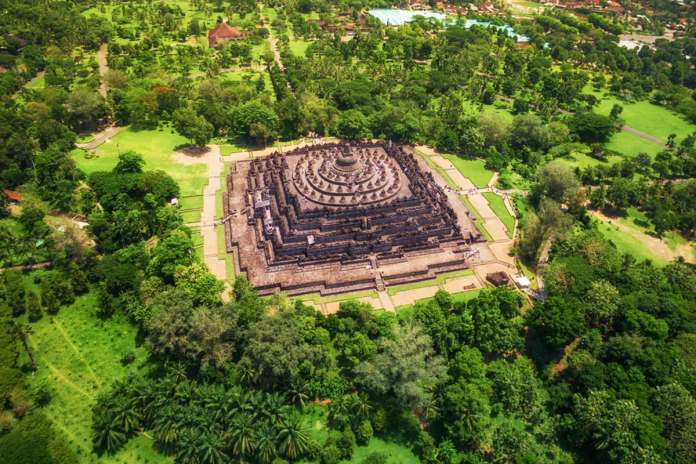With over 17,000 islands, Indonesia is the world’s largest island country and boasts of mesmerising history and culture. The country has numerous heritage monuments, and one of them is truly marvellous in every sense. Yes, we are talking about the Borobudur Temple, which is the largest Buddha temple in the world! The 9th-century temple is made in the form od a Stupa and looks absolutely grand. Scroll down to know more about it.
All About Borobudur Temple
Located on the island of Java, the spectacular Borobudur temple is the world’s largest Buddist temple. The temple sits magnificently on a hilltop overlooking the distant hills and lush green fields. Built-in the 9th century during the reign of the Syaliendra dynasty (King of the Mountain) and the temple’s design, is in Gupta architecture that reflects India’s influence on the region. It is a shrine to the Lord Buddha and a holy place for Buddhist pilgrimage.
The temple guides all the pilgrims through an extensive system of corridors and stairways with 1,460 narrative relief panels on the walls. Borobudur Temple has one of the largest and complete ensembles of Buddhist reliefs in the world. The design of the temple is just marvellous and is decorated with 2,672 relief panels and 504 Buddha statues.

Image Source: Jararkta Post 
Image Source: britannica
Studies believe that while it was constructed in the 9th century, it subsequently started to get abandoned following the 14-century decline of Hindu kingdoms in Java and the Javanese conversion to Islam. The knowledge about the existence of Borobudur Temple was prompted in 1814 by Sir Thomas Stamford Raffles (then the British ruler of Java) who was advised of its location by Indonesians.
Between 1975 and 1982, the most significant restoration project was undertaken by the Indonesian government and UNESCO, followed by the listing as a UNESCO World Heritage Site.
History Behind The Largest Buddhist Temple
It is believed that the temple was built by King Samaratungga (descendants of Shailendra house, who glorifies God Indra). The construction began in 780 AD, and it took 75 years to complete in 830 AD. But in the era of 950 BC, Borobudur temple collapsed due to the eruption of Mount Merapi, and for centuries, the temple was buried under the eruption.

Until 1907 AB, the restoration of the temple began, and the voluptuous rocks were removed from the structure to cease the damage of the temple as per the instructions of Dutch (when Indonesia was under the rule). Finally, after the independence of Indonesia, the restoration of the temple was resumed with innovative technology and was completed in 1983. In 1991, UNESCO listed Borobudur temple as a World Heritage Site.
Design And Architecture of The Temple
The Borobudur temple covers an enormous area, measuring 56,600 cubic metres and the true magic of the temple is revealed with intricate carvings on the walls. The entire temple is decorated with stone carvings representing images from the life of Buddha. The Borobudur Temple comprises of three compounds- Mendut, Borobudur and Pawon. Mendut temple is 3 km east from the Borobudur, while the Pawon Temple is located between these two temples. Also, the Borobudur Temple is the largest of the three.
The architecture of the Borobudur temple is what sets it apart from other Buddhist temples apart from the scenic backdrop. The temple comprises of the three tiers:

Image SourceL Indo Global adventure
- With five concentric square terraces is the first tier which has a pyramidal base.
- The second tier is in a cone shape with three circular platforms.
- And last, the third tier is a monumental Borobudur stupa which is located at the top of the temple.
If you look closely at the groundwork of the temple, you will release that it resembles tantric Buddhist Mandala, a symbol of nature of mind and Buddhist cosmology. Meanwhile, the three tiers of the temple signify the three realms of the Buddhism- Kamadhatu (the world of desire), Rupadhatu (the world of forms), Arupadhatu (the formless world).
We are truly stunned by the beauty and history of this gorgeous looking Buddhist temple!
(Featured Image Source: Lonely Planet)




